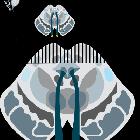artery of Percheron




The artery of Percheron is a rare variant of the posterior cerebral circulation characterized by a solitary arterial trunk that supplies blood to the paramedian thalami and the rostral midbrain bilaterally. From the original classification of arterial patterns at the origin of the paramedian arteries for the thalamus , this variant is described as type II. Type I refers to the standard bilateral independent vascularization from the proximal segment of both posterior cerebral arteries while type III regards the existence of a communicating artery between these two independent origins, with either thalamus receiving bilateral arterial supply.
Epidemiology
The artery of Percheron is estimated to occur in up to 33% of the population . Ischemic strokes affecting this artery are thought to be at the origin of 4-18% of all thalamic strokes .
Gross anatomy
The term is used to refer to a solitary arterial trunk that branches from one of the proximal segments of either posterior cerebral artery (PCA). It supplies blood to the paramedian thalami and, most often, the rostral midbrain bilaterally . Occasionally it supplies the anterior thalamus, particularly when the thalamotuberal (or polar) arteries are absent (30-60% of cases) .
History and etymology
It is named after the French neurologist Gérard Percheron, who described it in 1973 .
Related pathology
- Percheron infarct: bilateral thalamic and mesencephalic infarctions; clinically patients are often obtunded, comatose, or agitated, with associated hemiplegia or hemisensory loss
Siehe auch:
- intrakranielle arterielle Gefäßanomalien
- Arteria cerebri posterior
- Mesencephalon
- posterior cerebral circulation
- bilateraler Thalamusinfarkt
- percheron artery infarct
- paramedian thalami
und weiter:

 Assoziationen und Differentialdiagnosen zu Percheron-Arterie:
Assoziationen und Differentialdiagnosen zu Percheron-Arterie:





